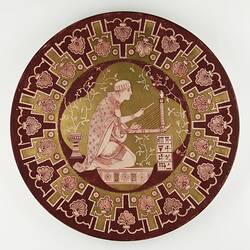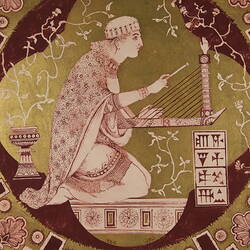Summary
Ceramic wall-plate decorated in the late-nineteenth century Aesthetic style with obvious Sumerian decorative motifs, signed 'GMS' and dated 1888 within the design.
This is one of two plates produced in a similar decorative style, possibly English and both signed by the same unidentified artist in 1888, that are understood to have been produced for inclusion in the 1888 Melbourne International Centennial Exhibition, which opened on 3 August 1888 and ran for six months, closing on the 31 January 1889.
Both of them depict harpists from two ancient civilisations, Sumerian in this instance, and Egyptian on the companion piece. Sumer was a historical region in southern Mesopotamia, is present-day Iraq, and one of the earliest civilisations that developed agricultural practices. The Sumerians were conquered in the 23rd century BC by the semitic-speaking Akkadians. The harp illustrated on this plate is known as an Akkadian pasaltiru, which in turn developed into the later Persian santur, a horizontal harp played with small mallets, called mesrabs. Early depictions of the santur show them being carried while being played, supported by a neck harness, also apparent in this illustration. The carved hand on the top of the frame is also a common feature of early representations of the santur.
While in style, the two plates have distinctive qualities of the Aesthetic movement that developed in Europe, particularly in England, from the 1860s, the design's central vine tendrils also show the influence of Orientalism, the appeal of the Far East in Western art and design in the second half of the nineteenth century following the opening of Japan to the West at the end of the Edo period in 1867.
According to the donor's family history, the two plates were purchased from the 1888 Melbourne Centennial International Exhibition by an 'Aunty Vi', who in turn left them to her niece, Violet Joseph, a close friend of the donor's mother.
Physical Description
Ceramic plate with reddish-brown painted glaze and gilt decoration, depicting a Sumerian harpist in the centre of the plate and a rectangular cartouche with cuneiform script. The broad border design is a repeating geometric stepped pattern with fanned feather or ferns fronds.
More Information
-
Collecting Areas
-
Acquisition Information
Donation from Owen Marks, 2012
-
Date Manufactured
-
Place & Date Exhibited
Exhibition: 1888 Centennial, Melbourne, Melbourne, Greater Melbourne, Victoria, Australia, Aug 1888-Jan 1889
-
Place & Date Purchased
Melbourne, Greater Melbourne, Victoria, Australia, Aug 1888-Jan 1889
-
Inscriptions
Painted in red within design: GMS/ 1888
-
Classification
Royal exhibition building, International exhibitions, Exhibition heritage
-
Category
-
Discipline
-
Type of item
-
Overall Dimensions
309 mm (Length), 310 mm (Width), 20 mm (Height)
-
Keywords
Exhibitions, Exhibitions: Melbourne International Centennial, 1888-1889, Art Exhibitions, Ceramics, Egyptian


